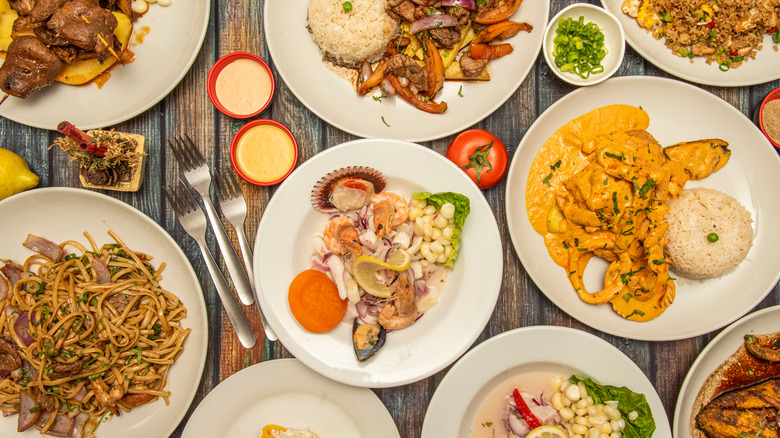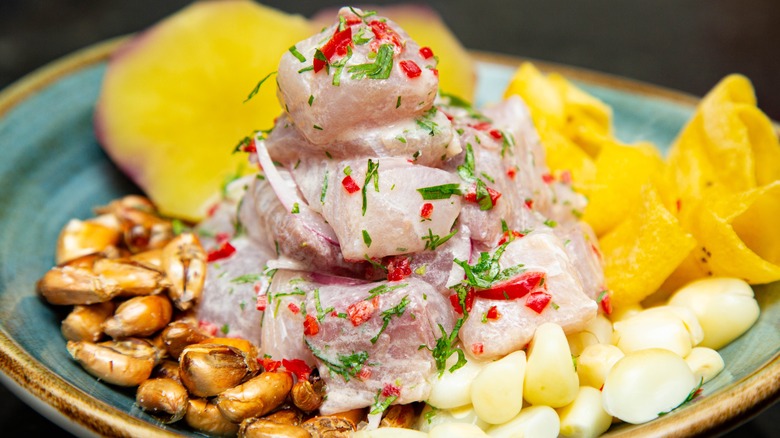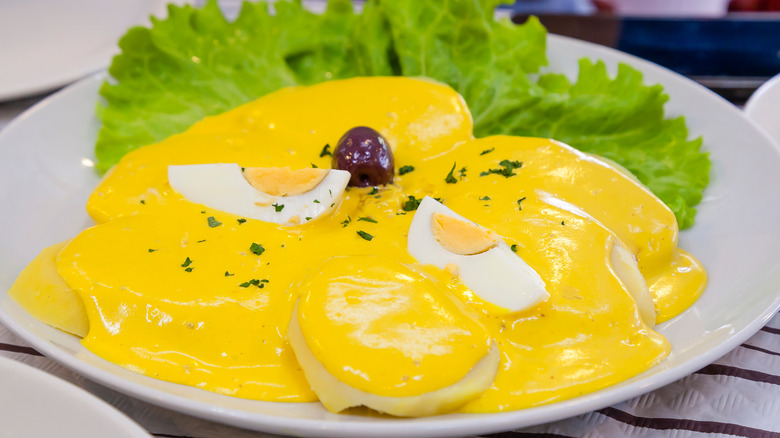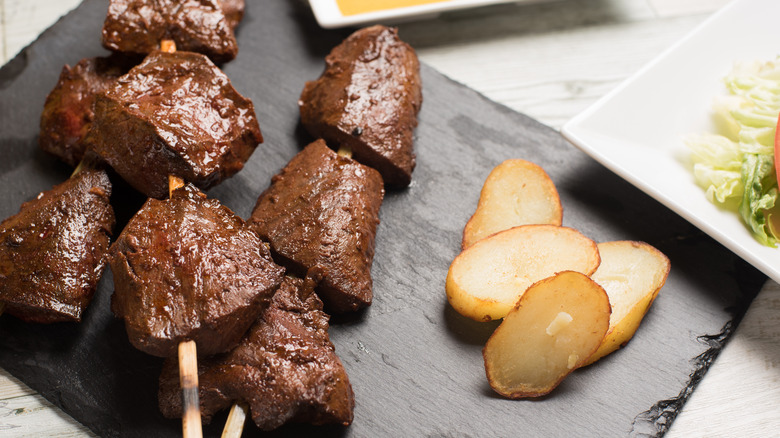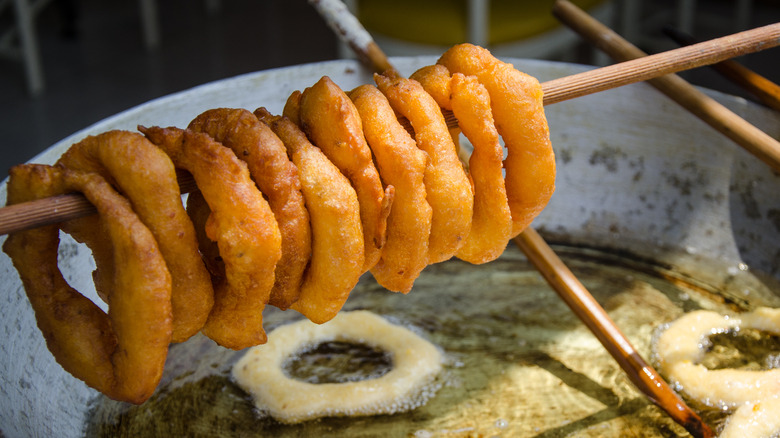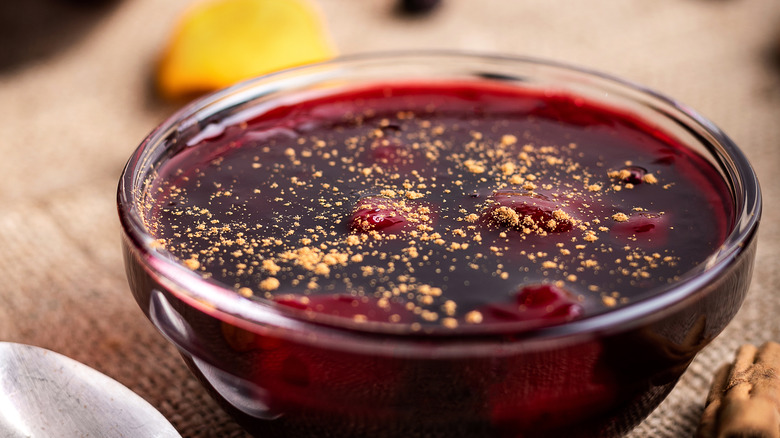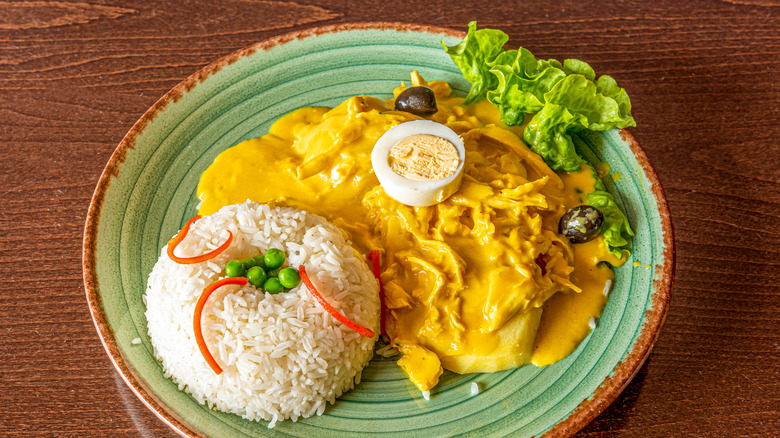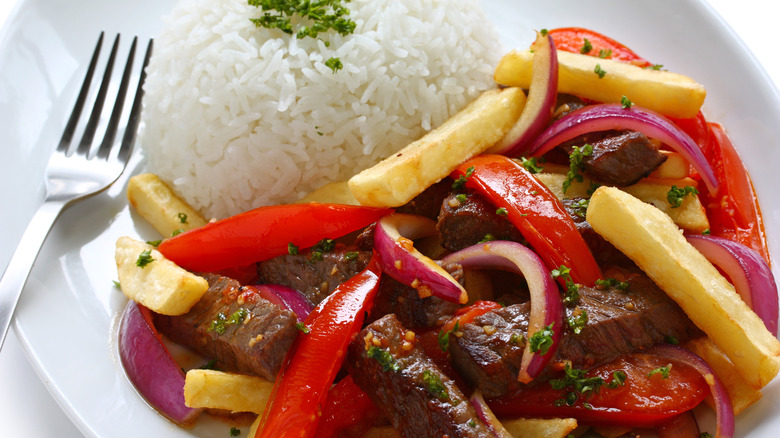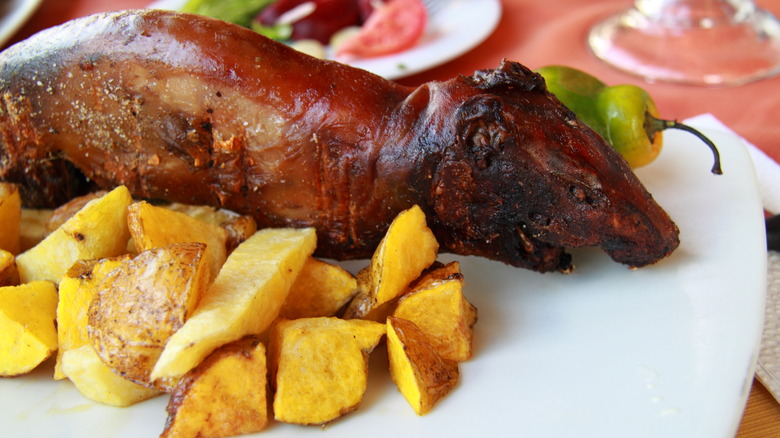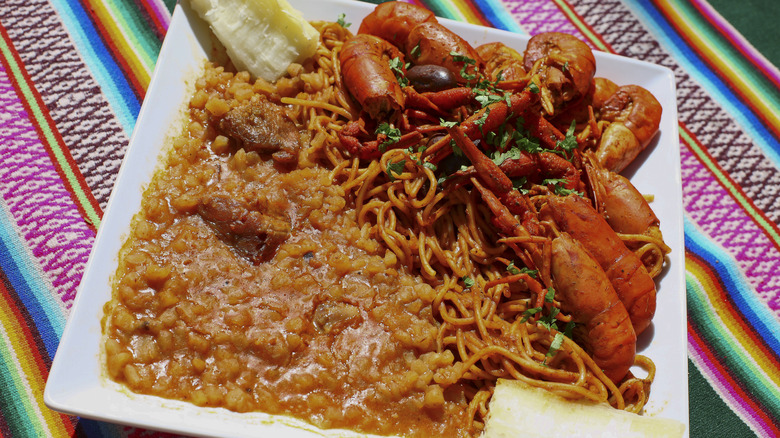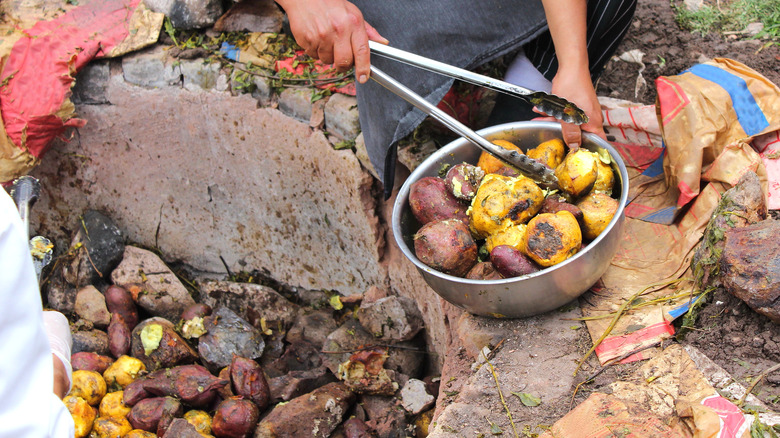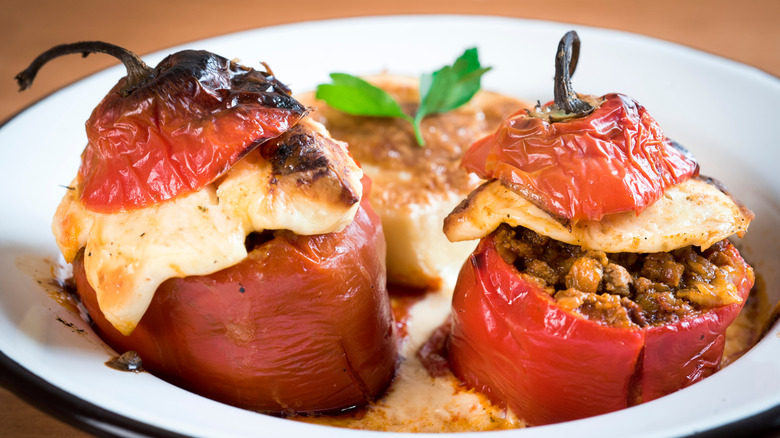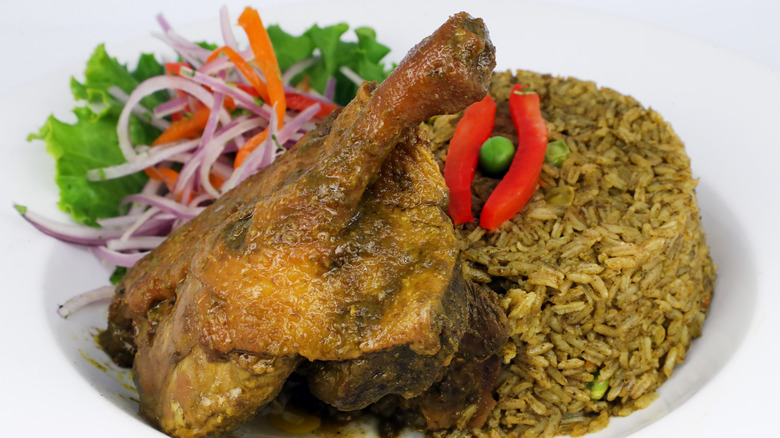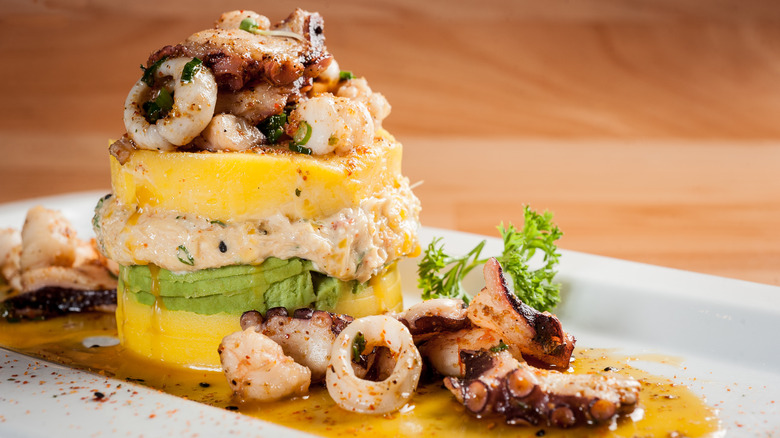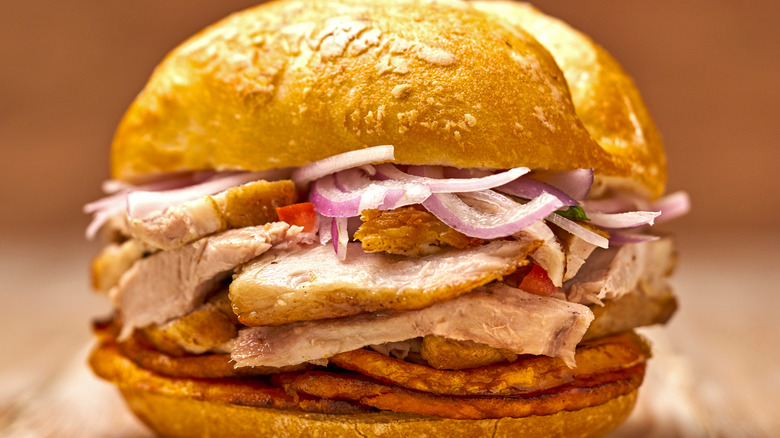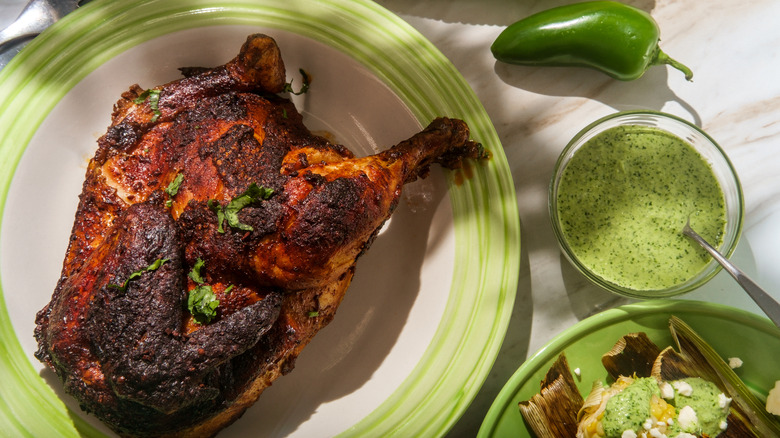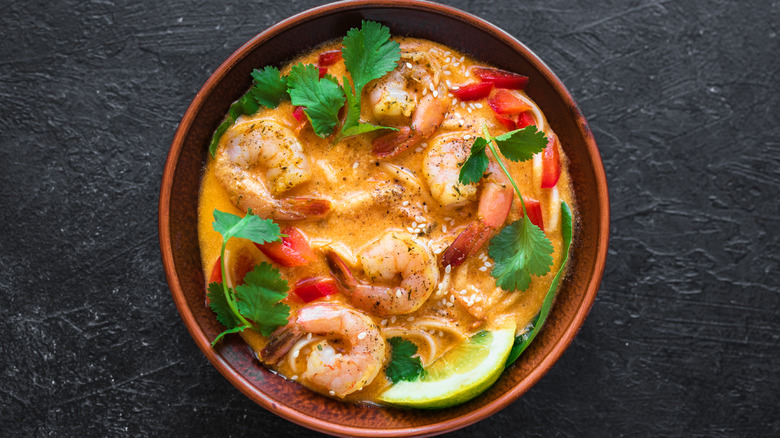Iconic Peruvian Foods You Have To Try Before You Die
Today's Peruvian cuisine is the culmination of influences from native civilizations, like the Inca, and global sources, such as Spanish conquistadors (via Peru Adventure Tours). In the 16th century, European explorers arrived with foods such as grapes, chicken, rice, and dairy items, sparking a fascinating food evolution. The influence went both ways: Michelin Guide notes that the Spanish brought Peruvian staples like potatoes and maize back with them to Europe.
Imported slaves and indentured laborers also ushered in African, Chinese, and Japanese culinary traditions. These foreign tastes spawned new gastronomic subcultures, such as Criollo (Creole), Chifa, and Nikkei (via Machu Travel Peru), that combined Peruvian ingredients with seasonings and cooking techniques from other places. Italian immigrants also introduced elements of their native cuisine, including pasta, eggplant, and basil. Put it all together and the result is a fusion cuisine like no other, one that tells the story of a country's tumultuous past and fascinates adventurous eaters from around the world.
Ceviche
Ceviche, Peru's national dish, consists of cubed white fish (e.g., sea bass, rockfish) that has been marinated in lime or lemon juice and flavored with chilis and cilantro. While this iconic dish is made with the freshest seafood possible and is not cooked in the traditional sense, it is also not technically raw. Interestingly, the acid in the lime juice "cooks" the fish by denaturing protein (via Special Broadcasting Service of Australia).
According to Christian Manrique, a Cordon Bleu chef who hails from Peru's capital city Lima, assembling the dish in the correct order is crucial to making a successful, authentic ceviche. In an interview with Culture Trip, he explains that seasoning should come first, then mixing, and finally the lime juice marinade. He also recommends not cubing the fish too small so as to avoid oversaturation.
National Geographic UK writes that ceviche is a Peruvian dish that dates back thousands of years. However, citrus fruits were not brought to Peru until after the arrival of Spanish explorers. So it's a classic example of how ancient local tradition meets international influence to create something that, today, is uniquely Peruvian.
Papa a la Huancaína
Potatoes and chili peppers have been two of Peru's most prominent native crops for thousands of years (via USIL International Repository), and both of them are used in this traditional recipe. The International Potato Center, which is headquartered in Lima, asserts that most of the world's 4,000 varieties of potatoes come from the Andean highlands, so it's no wonder they're featured in countless Peruvian meals.
This comforting appetizer blends onions, ají chilis, and evaporated milk with queso fresco for a zesty, cheesy sauce that is generously poured over boiled potatoes (via The Spruce Eats). Served cold, this incredibly hearty dish is typically topped off with some hard-boiled eggs and olives. But this golden, creamy Huancaína sauce isn't just limited to one dish. Make good use of a great thing by pairing it with noodles, yuca fries, rice, and anything else that would be improved with cheese.
Anticuchos
In any country, street food is a marvelous window into the local culture and gastronomy. One of the most emblematic street foods of Peru is anticuchos, a kind of kebab. While these grilled, seasoned meat skewers can be made with beef or chicken, the most traditional type is made with cow hearts.
This common Peruvian street food, typically served with boiled potatoes or corn, has roots in both native and African cultures. According to Traveling & Living In Peru, the concept of eating meat this way dates back to before the arrival of the Spanish. Back then, however, locals would eat llama meat. It wasn't until the Spanish came to Peru that eating beef became common. The Spanish often reserved offal cuts like heart for the enslaved African laborers they brought to Peru. Afro-Peruvians popularized grilling marinated beef hearts, and now, grilled cow hearts seasoned with ají chilis (of course), garlic, cumin, and black pepper are ubiquitous in the South American nation.
Picarones
While Peruvian cuisine is dominated by meat, this drool-worthy fried dessert is one that even vegetarians can enjoy. Picarones, another beloved Lima street food with similar origins to anticuchos, are doughnuts made with squash and sweet potato, or pumpkin and sweet potato. This late-night snack is a twist on Spanish doughnuts called buñuelos (via The Guardian).
Africans enslaved by the Spanish adapted buñuelos, adding mashed sweet potato and squash to the dough recipe. Thus, they created their own version of the European-born dessert — a recipe that soon became a Peruvian favorite. While buñuelos are generally ball-shaped, picarones are formed into rings, which allows them to be threaded onto wooden sticks when they're done cooking.
This delightful treat is usually coated with a honey-like syrup made with unrefined cane sugar (chancaca), cinnamon, cloves, and orange peel. If you can't get down to Lima to visit a street vendor, you can try this crispy, sweet, spiced dessert at home with this recipe from Amigo Foods.
Mazamorra Morada
Another Peruvian dessert that can be found in restaurants and on street corners alike is mazamorra morada. This purple-hued pudding is made using purple corn, fruits such as pineapple, peaches, and cherries, and spices like cinnamon and anise. Its thick, jelly-like consistency comes from the addition of sweet potato flour or corn starch (Get the recipe from Eat Peru).
Historically, this dessert was served warm during Lima's winter celebrations, but today, it is enjoyed all over the country and throughout the year (via Commission for the Promotion of Peruvian Exports and Tourism). It can be served alone, but is also often paired with another sugary Peruvian staple: arroz con leche, or rice pudding. Called a "combinado," the purple and white desserts are served side by side for a decadent combination of flavors. It's also a combination of cultures, with some ingredients originating from Peru (corn and sweet potato) and some originating from Spain (rice and milk).
Ají de Gallina
Another yellow, creamy Peruvian dish is called ají de gallina. To make it, shredded chicken is soaked in a thick sauce made from evaporated milk, bread, Parmesan cheese, garlic, onions, and pecans (via Peru Delights). Like Papa a la Huancaína, the entree is served with boiled potatoes and topped with hard-boiled eggs and olives. This nutty, creamy, spicy, salty dish that marries Peruvian and European ingredients also often comes with a side of white rice.
According to the Commission for the Promotion of Peruvian Exports and Tourism, ají de gallina is actually a savory evolution of blancmange, a type of sweet chicken-and-rice pudding that came to Peru from Spain. The original sweet recipe is said to have mutated over the years with the addition of local ingredients, like the ever-present ají yellow pepper. Chicken, cheese, and other foods eventually turned it into the celebrated dinner meal that it is today.
Lomo Saltado
Chinese immigrants first arrived in Peru in the 19th century. According to Taiwanese historian Diego Chou, many of them had been kidnapped or tricked into boarding ships so they could serve as indentured servants in South America (via Milenio). Though most of the Chinese workers faced terrible conditions, including racism, they were able to maintain some of their own traditions — mainly, the culinary ones.
The Chinese newcomers exposed Peruvians to ingredients such as ginger and soy, as well as to Asian cooking methods (via Peru Adventure Tours). Eventually, this led to the establishment of local Chinese eateries and the preparation of traditional Asian dishes with Peruvian ingredients. This fusion cuisine has since been dubbed Chifa and has birthed dishes like lomo saltado, a Peruvian beef stir-fry made with tomatoes, onions, soy sauce, and aji peppers, often served with thick-cut fries or white rice. Other Chifa dishes include arroz chaufa (Peruvian fried rice) and pollo chi jau kay (fried chicken with oyster sauce).
Cuy
This is a Peruvian staple that won't sit well with many pet owners, but has won the heart of "Bizarre Foods" host Andrew Zimmern, according to his website. One of the most frequently consumed types of meat in Peru is that of the guinea pig, known there as "cuy." And it has been a local favorite for approximately 5,000 years (via CNTraveler).
To make matters worse for those who already find the idea of eating guinea pig disturbing, cuy is typically served whole — face, feet, and all. In Peru, these little animals can be roasted, fried, or baked. They are sold by street vendors as well as restaurants (cuyerías), and the taste is often described as being a cross between rabbit and chicken.
Cuy is such a big part of Peruvian culture that the country even has National Guinea Pig Day every October (via Rove). During the festival, there is usually a fashion contest featuring live guinea pigs that have been dressed up by the locals. After the fashion show, of course, revelers are served cooked cuy.
Carapulcra
Carapulcra is another Peruvian dish that has undergone a long history of evolution. According to Eat Peru, carapulcra was a meat stew first invented by native Andeans, typically prepared with llama or alpaca meat and dried potatoes. But with the arrival of foreigners came the inclusion of new ingredients; alpaca was replaced with pork and chicken brought by the Spanish, and peanuts were added to the recipe by Africans.
Today, the brown stew is also made with garlic, onions, cumin, and — you guessed it — ají chili peppers. It is frequently served with white rice. However, when it is served with Peruvian spaghetti (sopa seca) that has been flavored with basil and other spices, it becomes a dish known as manchapecho. So not only does one get to experience Peruvian, Spanish, and African influences, but Italian as well (Like the Chinese, Machu Travel Peru writes that the Italians also arrived in Peru in the 19th century).
Pachamanca
In America, we have community barbecues. In Peru, they have pachamanca. It's an occasion where people get together to cook food in the ground. "Pachamanca" literally means "earth oven" or "earth pot" (via Serious Eats). It's an all-day affair that takes hours of preparation, and it's been part of Peruvian tradition for centuries. If you find yourself in Peru, attending a pachamanca would be a truly authentic way to experience the local culture.
First, a pit is dug in the ground. Then, bricks are assembled to create a makeshift oven. Volcanic rocks are then heated over a fire and thrown into the pit. Whole potatoes are the first ingredient to begin cooking. After that comes big chunks of seasoned meat, such as chicken, lamb, beef, pork, etc., which are then covered by banana leaves. Lastly, fava beans, corn, and tamales are added to the pit. All of this is finally covered and left to cook for several hours. The end result is a huge feast that an entire community can enjoy together.
Rocoto relleno
Everyone is familiar with stuffed peppers, but what sets the Peruvian version apart is the heat level. Peru's native rocoto peppers, which are about the size of tomatoes, are similar to habanero peppers in terms of spiciness, with a range of 30,000 to 100,000 SHU (via Pepper Scale). This dish from the southern Peruvian city of Arequipa packs a punch. As for the filling, it's a mixture of beef, raisins, olives, hard-boiled egg, onions, and peanuts, all topped off with tons of melted cheese (via Amigo Foods).
Rocoto peppers are also used in various other Peruvian recipes, including sauces, stews, and salsas (Try this recipe from Eat Peru for a rocoto pepper cream sauce that can pair with everything from fries to chicken). Like bell peppers, they can come in various colors, but the red rocoto pepper is the one most associated with the famous dish from Arequipa.
Arroz con Pato
Rice with duck may sound like an average meal that can be found practically anywhere, but this northern Peruvian dish from Chiclayo has a special ingredient: beer. Both the duck legs and the rice are simmered in dark beer for a rich meal that has a unique depth of flavor.
In their recipe, Amigo Foods recommends marinating the duck in beer for several hours prior to cooking. After the meat is cooked in the pan, the remaining combination of beer and duck stock is used to cook the vegetables and the rice. Cilantro, cumin, and other spices provide even more dimension.
There is also another very similar Peruvian rice recipe, arroz con pollo, that is made with chicken instead of duck. Eat Peru notes that the traditional recipe calls for a Peruvian corn beer, chicha de jora, which, according to Trip Savvy, dates back thousands of years.
Causa
Peruvian causa consists of tuna salad sandwiched between two round mashed potato patties that have been infused with aji peppers and other spices (via Eat Peru). Unlike American mashed potato dishes, causa is generally served cold. If you're expecting the bland starchiness of American mashed potatoes, the citrusy bite of causa will be quite surprising. The filling can be changed to virtually any kind of seafood salad or chicken salad and often includes avocado and hard-boiled egg. This versatile dish can even be made vegetarian by replacing the tuna salad with egg salad or sautéed vegetables.
What makes causa such a beloved food — aside from the fact that it makes use of several iconic Peruvian ingredients — is the delightful contrast of the starchy potatoes and the creamy mayo-based filling. And because it can all be savored in a single bite, one can experience every element simultaneously. Causa can be eaten as either an appetizer or a midday meal.
Pan con chicharrón
Pan con chicharrón is to Peruvians what the bacon, egg, and cheese is to Americans: the ultimate breakfast sandwich. Fried pork belly, sweet potatoes, and salsa criollo (onion chili relish) sit happily inside a bread roll for a start-of-day meal that is crispy, salty, and tangy all at once.
According to Amigo Foods, pan con chicharrón originally comes from Andalusia, Spain, but since being brought to South America, it has been fully embraced as part of Peruvian food culture. There are even restaurants in Peru called chicharronerías that specialize in it, serving it either in sandwich form or as a plate with bread on the side. Pair it with a hot cup of coffee and you've got yourself an authentic Peruvian morning meal.
To make it at home, Amigo Foods recommends brining the pork for several hours first. To ensure that the meat ends up being moist on the inside and crispy on the outside, boil the pork in a pot until all the water evaporates, then fry it until golden brown.
Pollo a la Brasa
Peru is a special place as it relates to the history of roast chicken. While heating meat over a fire is as ancient as, well, fire, the six-spit rotisserie oven was only invented in 1950. According to The Washington Post, Swiss immigrants Roger Schuler and Franz Ulrich designed the technique while living near Lima, in an effort to roast more chickens at a faster pace. After that, specialty restaurants called pollerías began popping up, including Schuler and Ulrich's own La Granja Azul. And so, Peru became a capital of sublime roast chicken.
The typical pollo a la brasa recipe, like the one by Eat Peru, relies on a soy sauce-based marinade with spices like cumin and pepper. Once fully cooked, the chicken is commonly served with thick-cut fries and a freshly made salad. Dips for the roast chicken can include mayonnaise, ketchup, and mustard, but the most important is ají verde (green chili sauce).
Chupe de Camarones
Chupe de camarones is a spicy, creamy shrimp stew from Arequipa, Peru. This dish is so delicious that CNN listed it as one of the world's best soups. It's made with cheese, potatoes, milk, rice, ají chili paste, tomato paste, and a sunny-side-up egg, amongst other ingredients. It's more of a hearty, stick-to-your-ribs meal than just a light soup. In addition to filling your belly, chupe de camarones is also rumored to be an aphrodisiac.
Chupe de camarones takes hours to make, but the results are well worth the time and the effort. When cooking it at home, Peru Delights recommends making the shrimp stock yourself using the heads of the shrimp (of course, you'll strain those out later.) But catching a plane to northern Peru and dining at an authentic picantería (spicy food eatery) can't be beat, so if you're a foodie who's keen on experiencing the real deal, put it on your bucket list.
